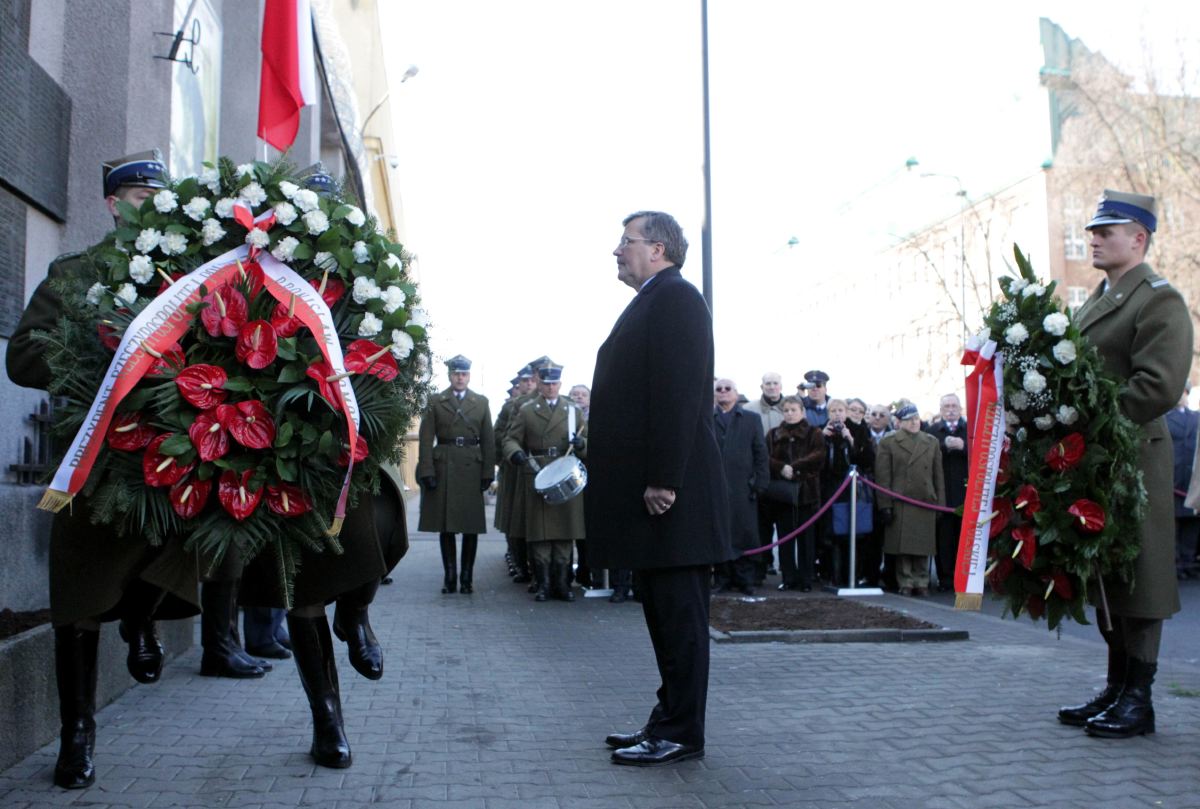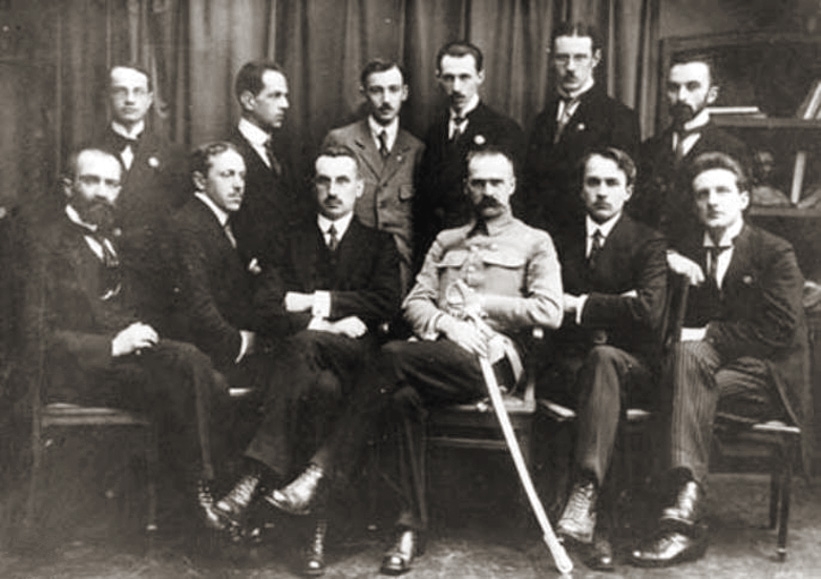|
Władysław Liniarski
Władysław Liniarski, alias Mścisław, Wuj, Jan (born November 23, 1897 in Małachowice-Gustawów - April 12, 1984 in Warsaw) was a colonel of the Polish Armed Forces, commander of the Białystok District of the Union of Armed Struggle from February to September 1941, commander of the Białystok District of the Union of Armed Struggle-Home Army (continuously for 5 years), from January 1945 commander of the Białystok District of the Citizens' Home Army. Activist of the post-war anti-communist underground, victim of communist repressions. In 1979 he became a member of the Committee for the Agreement for the Self-Determination of the Nation. In 2017 posthumously promoted to the rank of brigadier general Biography Son of Jan and Józefa née Bielanowicz, owners of a two-morgen farm he was born in Małachowice-Gustawów in the Włoszczowa County of the Kielce Governorate. After graduating from primary school in 1913, he began studying at a teachers' seminary in Jędrzejów. He int ... [...More Info...] [...Related Items...] OR: [Wikipedia] [Google] [Baidu] |
Anti-communist Resistance In Poland (1944–1953)
The anti-communist resistance in Poland, also referred to as the Polish anti-communist insurrection fought between 1944 and 1953, was an anti-communist and anti-Soviet armed struggle by the Polish Underground against the Soviet domination of Poland by the Soviet-installed People's Republic of Poland, since the end of World War II in Europe. The guerrilla warfare conducted by the resistance movement formed during the war, included an array of military attacks launched against communist prisons, state security offices, detention facilities for political prisoners, and prison camps set up across the country by the Stalinist authorities. In January 1945, the pro-Soviet government installed in Poland by the advancing Red Army declared as "illegal" the Polish anti-Nazi resistance movement, principally the Home Army, and ordered its surviving members to come out into the open while guaranteeing them freedom and safety. Many underground fighters decided to lay down their arms and ... [...More Info...] [...Related Items...] OR: [Wikipedia] [Google] [Baidu] |
24th Infantry Regiment (Poland)
The 24th Infantry Regiment is a unit of the United States Army, active from 1869 until 1951, and since 1995. Before its original dissolution in 1951, it was primarily made up of African American soldiers. History The 24th Infantry Regiment (one of the Buffalo Soldier regiments) was organized on 1 November 1869 from the 38th U.S. Infantry Regiment (formed 24 July 1866) and the 41st U.S. Infantry Regiment (formed 27 July 1866). All the enlisted soldiers were black, either veterans of the U.S. Colored Troops or freedmen. From its activation until 1898, the 24th Infantry served throughout the Western United States. Its missions included garrisoning frontier posts, fighting Native Americans, protecting roadways against bandits, and guarding the border between the United States and Mexico. Medal of Honor: * Wham Paymaster Robbery, Arizona Territory 11 May 1889 ** Sergeant Benjamin Brown, Corporal Isaiah Mays * Black Seminole: United States Scouts, Canyon Blanco, Staked Plains, ... [...More Info...] [...Related Items...] OR: [Wikipedia] [Google] [Baidu] |
Polish Military Organization
The Polish Military Organisation, PMO (, POW) was a secret military organization that was formed during World War I (1914–1918). Józef Piłsudski founded the group in August 1914. It adopted the name ''POW'' in November 1914 and aimed to gather intelligence and to sabotage the enemies of the Polish people. Piłsudski used it to act independently from his cautious Austro-Hungarian supporters, and it became an important, if somewhat lesser known, counterpart to the Polish Legions. Its targets included the Russian Empire in the early phase of the war and the German Empire later. Its membership rose from a few hundred in 1914 to over 30,000 in 1918. History Intelligence and training The Polish Military Organization (PMO) can be traced to formations of August 1914 or even earlier, but it was officially founded in November 1914 as a merger of two previously existing youth para-military organisations: the Polish Rifle Squads and the Riflemen's Association. Active in the Russian-hel ... [...More Info...] [...Related Items...] OR: [Wikipedia] [Google] [Baidu] |
Kielce Governorate
Kielce Governorate was an administrative-territorial unit ('' guberniya'') of Congress Poland of the Russian Empire. History It was created in 1841 from the Kraków Governorate, both with capital in Kelets (Кѣльцы). It was merged into Radom Governorate during the 1844 reorganisation that reduced the number of governorates to just five. In 1866/67 it was recreated in the further reforms that brought the administrative structure of Poland closer to that of the Russian Empire. It consisted of 7 powiats: Jędrzejów, Kielce, Miechów, Olkusz, Pińczów, Stopnica Stopnica is a town in Busko County, Świętokrzyskie Voivodeship, in south-central Poland. It is the seat of the gmina (administrative district) called Gmina Stopnica. It lies in Lesser Poland, approximately east of Busko-Zdrój and south-east o ... and Włoszczowa. Language *By the Imperial census of 1897. [...More Info...] [...Related Items...] OR: [Wikipedia] [Google] [Baidu] |
Włoszczowa County
__NOTOC__ Włoszczowa County () is a unit of territorial administration and local government (powiat) in Świętokrzyskie Voivodeship, south-central Poland. It came into being on January 1, 1999, as a result of the Polish local government reforms passed in 1998. Its administrative seat and only town is Włoszczowa, which lies west of the regional capital Kielce. The county covers an area of . As of 2019 its total population is 45,137, out of which the population of Włoszczowa is 9,985, and the rural population is 35,152. Neighbouring counties Włoszczowa County is bordered by Końskie County to the north-east, Kielce County to the east, Jędrzejów County to the south-east, Zawiercie County to the south-west, and Częstochowa County and Radomsko County to the west. Administrative division The county is subdivided into six gmina The gmina (Polish: , plural ''gminy'' ) is the basic unit of the administrative division of Poland, similar to a municipality. , there were 2,479 g ... [...More Info...] [...Related Items...] OR: [Wikipedia] [Google] [Baidu] |
Union Of Armed Struggle
The Union of Armed StruggleThus rendered in Norman Davies, ''God's Playground: A History of Poland'', vol. II, p. 464. (; ZWZ), also translated as the Union for Armed Struggle, Association of Armed Struggle, and Association for Armed Struggle, was an underground army formed in Poland following its invasion in September 1939 by Germany and the Soviet Union that opened World War II. It existed from 13 November 1939 until 14 February 1942, when it was renamed into Home Army (''Armia Krajowa, AK''). Union of Armed Struggle was created from an earlier organization, Service for Poland's Victory (''SZP''). In January 1940, it was divided into two parts: *areas under German occupation — commanded by Colonel Stefan Rowecki, headquartered in Warsaw; *areas under Soviet occupation — commanded by General Michał Karaszewicz-Tokarzewski, headquartered in Lwów. Formally, the Union of Armed Struggle was directed from Paris, by General Kazimierz Sosnkowski (nom de guerre Józef Go ... [...More Info...] [...Related Items...] OR: [Wikipedia] [Google] [Baidu] |
Partisan Cross
The Partisan Cross () was a Polish military decoration awarded to World War II partisans (part of resistance movement fighting in the countryside). It was introduced by the Council of Ministers on October 26, 1945. It was awarded from 1945 until 1999. It was awarded to organizers, commanders and members of partisan units who fought against Germans on a Polish territory, or to Poles who fought in partisan units in the USSR, Yugoslavia and France, or to foreigners, who fought in partisan units on a Polish territory. It could be given also to cities or villages, that distinguished themselves in supporting the partisan movement. It was awarded first by the Ministry of Defence, from 1952 by the Council of State, from 1989 by the President of Poland. It ceased to be awarded in 1999. About 55,000 Partisan Crosses were awarded. Description The Cross is a gold-plated Greek cross with thin arms, 38 x 38 mm. Obverse shows the eagle Eagle is the common name for the golden ... [...More Info...] [...Related Items...] OR: [Wikipedia] [Google] [Baidu] |
Medal For Long Service
The Medal for Long Service (Polish: ''Medal za Długoletnią Służbę'') is a Polish decoration awarded in three classes (gold, silver and bronze) to members of the Polish Armed Forces and other uniformed services, and to Civil Servants, civil servants who have honorably completed 30, 20 or 10 years of service to the State. History The medal was established by the Law of January 8, 1938. After the outbreak of the Second World War the conferment was suspended, and after the war the medal was eventually discontinued. In 1951, it was replaced by the Medal of the Armed Forces in the Service of the Fatherland for members of the armed forces. The Medal for Long Service was revived by the Law of 14 June 2007, which amended the Act of 16 October 1992, concerning medals and decorations, along with the Military Cross (Poland), Military Cross and the Military Cross of Merit (Poland), Military, Air Force Cross of Merit (Poland), Air Force and Navy Cross of Merit (Poland), Navy Cross of Merit ... [...More Info...] [...Related Items...] OR: [Wikipedia] [Google] [Baidu] |
Cross Of Merit (Poland)
A cross is a religious symbol consisting of two intersecting lines, usually perpendicular to each other. The lines usually run vertically and horizontally. A cross of oblique lines, in the shape of the Latin letter X, is termed a saltire in heraldic terminology. The cross shape has been widely officially recognized as an absolute and exclusive religious symbol of Christianity from an early period in that religion's history.''Christianity: an introduction'' by Alister E. McGrath 2006 pages 321-323 Before then, it was used as a religious or cultural symbol throughout , in west and |
Cross Of Merit With Swords (Poland)
The Cross of Merit with Swords () is a Polish military award established October 19, 1942, by the Polish Government in Exile. Criteria The Cross of Merit with Swords is awarded for deeds of bravery and valor during time of war not connected with direct combat, and for merit demonstrated in perilous circumstances. The cross may be awarded twice in each grade to the same person (since 1992; earlier it has could be awarded four times). Grades The Order has three grades: Recipients * Stansilaw Lukaszewicz (Bronze Cross of Merit with Swords), Sargeant 10 Dragoons, 1 Polish Armoured Division, 1 Polish Corps for action at Falaise Gap, France 1944. * Bolesław Piwowarczyk (Bronze Cross of Merit with Swords), Sergeant 5th Kresowa Division, 2nd Polish Corps. * Paul Jacot (Silver Cross of Merit with Swords), Civilian For the courage and bravery shown within the Polish organisation (resistance) during the battle for independence on French territory in 1943 and 1944**.. *Maria Irena M ... [...More Info...] [...Related Items...] OR: [Wikipedia] [Google] [Baidu] |





